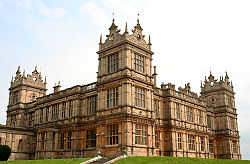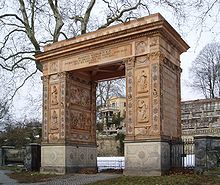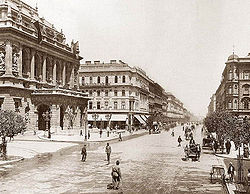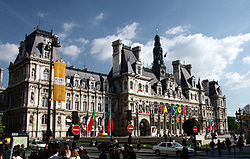- Renaissance Revival architecture
-
"Neo-Renaissance" redirects here. For the style of jewelery, see Holbeinesque jewellery.
 Mentmore Towers English Jacobethan Neo-Renaissance completed in 1854, derives motifs from Wollaton Hall completed in 1588.
Mentmore Towers English Jacobethan Neo-Renaissance completed in 1854, derives motifs from Wollaton Hall completed in 1588.
Renaissance Revival (sometimes referred to as "Neo-Renaissance") is an all-encompassing designation that covers many 19th century architectural revival styles which were neither Grecian (see Greek Revival) nor Gothic (see Gothic Revival) but which instead drew inspiration from a wide range of classicizing Italian modes. Under the broad designation "Renaissance architecture" nineteenth-century architects and critics went beyond the architectural style which began in Florence and central Italy in the early 15th century as an expression of Humanism; they also included styles we would identify as Mannerist or Baroque. Self-applied style designations were rife in the mid- and later nineteenth century: "Neo-Renaissance" might be applied by contemporaries to structures that others called "Italianate", or when many French Baroque features are present (Second Empire).
The divergent forms of Renaissance architecture in different parts of Europe, particularly in France and Italy, has added to the difficulty of defining and recognizing Neo-Renaissance architecture. A comparison between the breadth of its source material, such as the English Wollaton Hall,[1] Italian Palazzo Pitti, the French Château de Chambord, and the Russian Palace of Facets, — all deemed "Renaissance" — illustrates the variety of appearances the same architectural label can take.
Contents
Origins of Renaissance architecture
- Main article Renaissance architecture.
 The Palazzo Farnese, Rome 1534 -1545 Designed by Sangallo and Michelangelo. A patrician family house."..its dignified opulence later became the accepted style in Europe for clubs and banks"[2]
The Palazzo Farnese, Rome 1534 -1545 Designed by Sangallo and Michelangelo. A patrician family house."..its dignified opulence later became the accepted style in Europe for clubs and banks"[2]
The origin of Renaissance architecture is generally accredited to Filippo Brunelleschi (1377–1446)[3] Brunelleschi and his contemporaries wished to bring greater "order" to architecture, resulting in strong symmetry and careful proportion. The movement grew from scientific observations of nature, in particular human anatomy.
Neo-Renaissance architecture is formed by not only the severe original Italian architecture but by the form in which Renaissance architecture developed in France during the 16th century. During the early years of the 16th century the French were involved in wars in northern Italy, bringing back to France not just the Renaissance art treasures as their war booty, but also stylistic ideas. In the Loire valley a wave of chateau building was carried out using traditional French Gothic styles but with ornament in the forms of pediments, arcades, shallow pilasters and entablatures from the Italian Renaissance.
In England the Renaissance tended to manifest itself in large square tall houses such as Longleat House. Often these buildings had symmetrical towers which hint at the evolution from medieval fortified architecture. This is particularly evident at Hatfield House built between 1607 and 1611, where medieval towers jostle with a large Italian cupola. This is why so many buildings of the early English Neo-Renaissance style often have more of a "castle air" than their European contemporaries, which can add again to the confusion with the Gothic revival style.
Birth of the Neo-Renaissance
 Russia: The façade of the Vladimir Palace in Saint Petersburg (1867–72) redolent of Alberti's designs.
Russia: The façade of the Vladimir Palace in Saint Petersburg (1867–72) redolent of Alberti's designs.
When in the 19th century Renaissance style architecture into vogue, it often materialised not just in its original form according to geography, but as a hybrid of all its earlier forms according to the whims of architects and patrons rather than geography and culture. If this were not confusing enough, the new Neo-Renaissance then frequently borrowed architectural elements from the succeeding Mannerist period, and in many cases the even later Baroque period. Mannerism and Baroque being two very opposing styles of architecture. Mannerism was exemplified by the Palazzo del Te and Baroque by the Wurzburg Residenz.
Thus Italian, French and Flemish Renaissance coupled with the amount of borrowing from these later periods can cause great difficulty and argument in correctly identifying various forms of 19th century architecture. Differentiating some forms of French Neo-Renaissance buildings from those of the Gothic revival can at times be especially difficult, as both styles were simultaneously popular during the 19th century.
John Ruskin's panegyrics to architectural wonders of Venice and Florence contributed to shifting "the attention of scholars and designers, with their awareness heightened by debate and restoration work"[4] from Late Neoclassicism and Gothic Revival to the Italian Renaissance. As a consequence a self-consciously "Neo-Renaissance" manner first began to appear circa 1840. By 1890 this movement was already in decline. The Hague's Peace Palace completed in 1913, in a heavy French Neo-Renaissance manner was one of the last notable buildings in this style.
Charles Barry introduced the Neo-Renaissance to England with his design of the Travellers Club, Pall Mall (1829–32). Other early but typical, domestic examples of the Neo-Renaissance include Mentmore Towers and the Château de Ferrières, both designed in the 1850s by Joseph Paxton for members of the Rothschild banking family. The style is characterized by original Renaissance motifs, taken from such Quattrocento architects as Alberti. These motifs included rusticated masonry and quoins, windows framed by architraves and doors crowned by pediments and entablatures. If a building were of several floors the uppermost floor usually had small square windows representing the minor mezzanine floor of the original Renaissance designs. However, the Neo-renaissance style later came to incorporate Romanesque and Baroque features not found in the original Renaissance architecture which was often more severe in its design.
Like all architectural styles the Neo-Renaissance did not appear overnight fully formed but evolved slowly. One of the very first signs of its emergence was the Würzburg Women's Prison, which was erected in 1809 designed by Peter Speeth. It included a heavily rusticated ground floor, alleviated by one semicircular arch, with a curious Egyptian style miniature portico above, high above this were a sequence of six tall arched windows and above these just beneath the slightly projecting roof were the small windows of the upper floor. This building foreshadows similar effects in the work of the American architect Henry Hobson Richardson whose work in the Neo-Renaissance style was popular in the USA during the 1880s. Richardson's style at the end or the revival era was a severe mix of both Romanesque and Renaissance features.[5] This was exemplified by his "Marshall Field Warehouse" in Chicago (completed in 1887, now demolished).
However, while the beginning of Neo-Renaissance period can be defined by its simplicity and severity, what came between was far more ornate in its design. This period can be defined by some of the great opera houses of the Europe, such as Gottfried Semper's Burgtheater in Vienna, and his Opera house in Dresden. This ornate form of the Neo-renaissance, originating from France[6] is sometimes known as the "Second Empire" style, by now it also incorporated some Baroque elements. By 1875 it had become the accepted style in Europe for all public and bureaucratic buildings.[7] In England where Sir George Gilbert Scott designed the London Foreign Office in this style between 1860 and 1875 it also incorporated certain Palladian features.
Starting with the orangery of Sanssouci (1851), "the Neo-Renaissance became the obligatory style for university and public buildings, for banks and financial institutions, and for the urban villas" in Germany.[8] At Sanssouci in 1851, even the most established Roman idiom of the triumphal arch was abandoned and recast in a neo-Renaissance mode for Friedrich Wilhelm IV in erecting the Triumphtor in the hundred and sixth year, so its inscription states, since the founding of Sanssouci (illustration). Among the most accomplished examples of the style were Villa Meyer in Dresden, Palais Borsig in Berlin, Villa Meissner in Leipzig; the German version of Neo-Renaissance culminated in such turgid projects as the Town Hall in Hamburg (1886–97) and the Reichstag in Berlin (completed in 1894).
In Austria, it was pioneered by such illustrious names as Rudolf Eitelberger, the founder of the Viennese College of Arts and Crafts (today known as the University for Applied Arts). The style found particular favour in Vienna where whole streets and blocks were built in the so-called Neo-Renaissance style, in reality a classisizing conglomeration of elements liberally borrowed from different historical periods.
Neo-Renaissance was also the favourite style in Kingdom of Hungary in the 1870s and 1880s. In the fast growing capital, Budapest many monumental public buildings were built in Neo-Renaissance style like Saint Stephen's Basilica and the Hungarian State Opera House. Andrássy Avenue is an outstanding ensemble of Neo-Renaissance townhouses from the last decades of the 19th century. The most famous Hungarian architect of the age, Miklós Ybl preferred Neo-Renaissance in his works.
In Russia, the style was pioneered by Auguste de Montferrand in the Demidov House (1835), the first in Saint Petersburg to take "a story-by-story approach to facade ornamentation, in contrast to the classical method, where the facade was conceived as a unit".[9] Konstantin Thon, the most popular Russian architect of the time, used Italianate elements profusely for decorating some interiors of the Grand Kremlin Palace (1837–51). Another fashionable architect, Andrei Stackensneider, was responsible for Marie Palace (1839–44), with "the faceted rough-hewn stone of the first floor" reminiscent of 16th-century Italian palazzi.[10]
The style was further elaborated by architects of the Vladimir Palace (1867–72) and culminated in the Stieglitz Museum (1885–1896). In Moscow, the Neo-Renaissance was less popular than in the Northern capital, although interiors of the neo-Muscovite City Duma (1890–92) were executed with emphasis on Florentine and Venetian décor. While the Neo-Renaissance is associated primarily with secular buildings, Princes Yusupov commissioned the interior of their palace church (1909–16) near Moscow to be decorated in strict imitataton of the 16th-century Venetian churches.
The style spread to North America where as in Europe it was a favourite domestic architectural style of the very wealthy, The Breakers in Rhode Island, a residence of the Vanderbilt family, designed by R M Hunt in 1870 being a prime example. During the latter half of the 19th century 5th Avenue in New York was lined with "Renaissance" French chateaux, and Italian palazzi all in one or the other of the Neo-Renaissance styles. Most of these have since been demolished.
Features of the Neo-Renaissance
 A Renaissance staircase at the Château de Chambord completed in 1547. Variations of this design became a popular feature of the Neo-Renaissance.(See Waddesdon illustrated right)
A Renaissance staircase at the Château de Chambord completed in 1547. Variations of this design became a popular feature of the Neo-Renaissance.(See Waddesdon illustrated right)
One of the most widely copied features of Renaissance architecture were the great staircases from the chateaux of Blois and Chambord.[11] Blois had been the favourite residence of the French Kings throughout the renaissance. The Francis I wing, completed in 1524, of which the staircase is an integral part was one of the earliest examples of French Renaissance.[12] French renaissance architecture was a combination of the earlier Gothic style coupled with a strong Italian influence represented by arches, arcades, ballustrading and, in general, a more flowing line of design than had been apparent in the earlier Gothic. The Chateau de Blois's triumphal staircase was imitated almost from the moment of its completion, and was certainly the predecessor of the "double staircase" (sometimes attributed to Leonardo da Vinci) at the Château de Chambord just a few years later. A Grand Staircase whether based on that of Blois, or the Villa Farnese was to become one of the features of Neo-Renaissance design. It became a common feature for the staircase to be not just a feature of the internal architecture but also the external. But whereas at Blois the stairs had been open to the elements in the 19th century new and innovative use of glass was able to give protection from the weather, giving the staircase the appearance of being in the true renaissance open style, when it was in fact a truly internal feature. Further and more adventurous use of glass also enabled the open and arcaded Renaissance courtyards to be reproduced as lofty halls with glazed roofs. This was a feature at Mentmore Towers and on a far larger scale at the Warsaw University of Technology, where the large glazed court contained a monumental staircase. The "Warsaw University of Technology staircase", though if Renaissance in spirit at all, is more in the lighter, more columned style of Ottaviano Nonni's (named il Mascherino) staircase designed for Pope Gregory XIII at Rome's Palazzo Quirinale in 1584, thus demonstrating that architects wherever their location were selecting their Neo-Renaissance styles reardless of geography
Combined influences
Neo-Renaissance and Gothic
Strictly speaking, there are no similarities between Renaissance architecture and the Gothic. However, as the French Renaissance evolved from the addition of Renaissance ornament to Gothic based buildings, and also some architecture such as the courtyard of the Doge's Palace were constructed during the period of transition, occasionally some Gothic influences can be discerned. During the Neo-Renaissance period competent architects usually avoided all reference to the Gothic drawing instead on a variety of other classically based styles.[citation needed] However, there are exceptions and on occasions the two divergent styles were mixed. When this happened the chosen form of Gothic was often the floral Venetian Gothic.
Baroque influences in the Neo-Renaissance
A common Baroque feature introduced into the Neo-Renaissance was the "imperial staircase" (a single straight flight dividing into two separate flights). Paxton's staircase at Mentmore Towers and that at the Warsaw University of Technology (designed by Bronisław Rogóyski and Stefan Szyller in the late 19th century) both rise from pastiches of true Renaissance courtyards, yet both staircases seem more akin to Balthasar Neumann's great Baroque staircase at the Würzburg Residenz than anything found in a true Renaissance Palazzo. Yet the apparent Baroque style staircase at Mentmore is not without a Renaissance influence, its first flight is similar to "The staircase of the Giants" at the Venetian Doge's Palace which rises from a courtyard constructed when the Venetian Gothic was being uncomfortably merged with Renaissance style. Similarly to that at Mentmore, the Staircase of the Giant's terminates on to an arcaded loggia. Perhaps not ironically the Hall and Staircase at Mentmore were designed by Paxton to display furniture formerly housed in the Doge's Palace.
Paris has many buildings in a combined style of Neo-Renaissance and Baroque, such as the Opera Garnier, which seem to fit into neither category. However, the Parisian Hôtel de Ville is firmly in the true Renaissance style as it evolved in France, complete with the steeply pitched roofs and towers. The rebuilding completed circa 1880 faithfully reproduced the Renaissance architectural details of the previous Hôtel de Ville.[13] In another corner of the world far removed from Paris, the Writers' building in Kolkata was refaced according to the latest fashion in 1880. This building is amazing in its design. Loggias of Serlian arches form deceptively an almost Indian appearance, yet they sit beneath a Mansard roof. In what at first glance appears an Eastern building, yet on closere examination is a classic example of Palladianism combined with French Renaissance, an almost unique example of this style of Neo-Renaissance.
Neo-Renaissance Interiors
 True Renaissance: The Villa Farnese: the curved staircase, tall segmented windows, and marble balustrading. Were all features frequently reproduced in the 19th century revival
True Renaissance: The Villa Farnese: the curved staircase, tall segmented windows, and marble balustrading. Were all features frequently reproduced in the 19th century revival
As mentioned above, the Neo-Renaissance style was in reality an eclectic blending of past styles, which the architect selected on the whims of his patrons. In the true Renaissance era there was a division of labour between the architect, who designed the exterior highly visible shell, and others — the artisans — who decorated and arranged the interior.[14] The original Italian mannerist house was a place for relaxation and entertaining, convenience and comfort of the interior being a priority; in the later Baroque designs, comfort and interior design were secondary to outward appearance. This was followed by the Neoclassical period, which gave importance to the proportions and dignity of interiors, but still lost the comfort and internal convenience of the mannerist period. It was during the Neo-Renaissance period of the 19th century that the mannerist comforts were re-discovered and taken a step further. Not only did the improved building techniques of the 1850s allow the glazing of formerly open loggias and arches with the newly invented sheets of plate glass, providing the first "picture windows", but also the blending of architectural styles allowed interiors and exteriors to be treated differently. It was at this time that the concept of "furnishing styles" manifested itself, allowing distinctions to be made between interior rooms and external appearances, and indeed between the various rooms themselves.[14] Thus the modern concept of treating a room individually, and differently from its setting and neighbours, came into its infancy. Classic examples of this are the great Rothschild house in Buckinghamshire, hybrids of various Renaissance chateaux, and 16th century English country houses, all with interiors ranging from "Versailles" to "Medici", and in the case of Mentmore Towers a huge central hall, resembling the arcaded courtyard of a Renaissance villa, conveniently glazed over, furnished in Venetian style and heated by a fireplace designed by Rubens for his house in Antwerp[15]
Legacy
Provincial Neo-Renaissance English style: the NatWest Bank at Leighton Buzzard, Bedfordshire, England is an example of the manner in which Neo-Renaissance architecture evolved among lesser architects in more modest surroundings as it gained in popularity.
By the beginning of the 20th century Neo-Renaissance was a commonplace sight on the main streets of thousands of towns, large and small around, the world. In southern Europe the Neo-Renaissance style began to fall from favour circa 1900. However, it was still extensively practiced in the 1910s in Saint Petersburg and Buenos Aires by such architects as Leon Benois (picture), Marian Peretyatkovich (picture), or Francisco Tamburini (picture).
In England it was so common that today one finds "Renaissance Italian Palazzi" serving as banks or municipal buildings in the centres of even the smallest towns. It has been said "It is a well-known fact that the nineteenth century had no art style of its own."[16] While to an extent this may be true, the same could be said of most eras until the early 20th century, the Neo-Renaissance in the hands of provincial architects did develop into a style not always instantly recognisable as a derivative of the Renaissance. In this less obvious guise the Neo-Renaissance was to provide an important undercurrent in totalitarian architecture of various countries, notably in Stalinist architecture of the Soviet Union, as seen in some pavilions of the All-Soviet Exhibition Centre.
Neo-Renaissance architecture, because of its diversity, is perhaps the only style of architecture to have existed in so many forms, yet still common to so many countries.


Gottfried Semper's Dresden Semper Opera House of 1870, incorporating both Baroque and Renaissance architectural features. See also
Revival styles in Western architecture and decorative arts International Baroque Revival · Beaux-Arts · Neo-Byzantine · Carpenter Gothic · Châteauesque · Egyptian Revival · Gothic Revival · Greek Revival / Neo-Grec · Moorish Revival · Neoclassical · Renaissance Revival / Italianate · Romanesque Revival · Second EmpireBritish Empire Bristol Byzantine · Edwardian Baroque · Indo-Saracenic Revival · Jacobethan · Queen Anne Style · Scots Baronial Style · Tudor RevivalFrance Germany Greece Portugal Russian Empire and USSR Scandinavia Spain United States Jeffersonian architecture · American Renaissance · Colonial Revival · Mayan Revival · Mediterranean Revival · Mission Revival · Pueblo Revival · Queen Anne Style · Richardsonian Romanesque · Spanish Colonial Revival · Territorial RevivalHistory of architecture Neolithic · Ancient Egyptian · Coptic · Chinese · Dravidian · Mayan · Mesopotamian · Classical · Mesoamerican · Achaemenid Persia · Ancient Greek · Roman · Incan · Sassanid · Byzantine · Islamic · Newari · Buddhist · Somali · Persian · Pre-Romanesque · Romanesque · Romano-Gothic · Gothic · Plateresque · Manueline · Hoysala · Vijayanagara · Western Chalukya · Renaissance · Ottoman · Mughal · Baroque · Biedermeier · Classicism · Neoclassical · Historicism · Gründerzeit · Gothic Revival · Neo-Renaissance · Neo-Baroque · Rationalism · Modernisme · Art Nouveau · Expressionism · Modern · PostmodernReferences
- ^ "Wollaton Hall". Greatbuildings.com. http://www.greatbuildings.com/buildings/Wollaton_Hall.html. Retrieved 2011-06-11.
- ^ Copplestone, Trewin (1963). World Architecture. Hamlyn. Page 245
- ^ Copplestone, Trewin (1963). World Architecture. Hamlyn. Page 243
- ^ Rosanna Pavoni. Reviving the Renaissance: The Use and Abuse of the Past in Nineteenth-Century Italian Art. Cambridge University Press, 1997. ISBN 0-521-48151-1. Page 73.
- ^ Copplestone, Trewin (1963). World Architecture. Hamlyn. Pages 300 – 318
- ^ Copplestone, Trewin (1963). World Architecture. Hamlyn. Page 311
- ^ Copplestone, Trewin (1963). World Architecture. Hamlyn. Page 311 – caption 938,
- ^ The Cambridge Companion to Modern German Culture. Cambridge University Press, 1999. ISBN 0-521-56870-6. Page 283.
- ^ Julie A. Buckler. Mapping St. Petersburg: Imperial Text and Cityshape. Princeton University Press, 2004. ISBN 0-691-11349-1. Page 44.
- ^ Ibidem. Page 45.
- ^ Chateau de Chambord retrieved 19th April 2006
- ^ "Chateau de Blois". Castles.org. http://www.castles.org/castles/Europe/Western_Europe/France/france110.htm. Retrieved 2011-06-11.
- ^ "Hôtel de Ville". Aviewoncities.com. http://www.aviewoncities.com/paris/hoteldeville.htm. Retrieved 2011-06-11.
- ^ a b Dal Lago, Adalbert (1966). Ville Antiche. Milan: Fratelli Fabbri.
- ^ Sotheby's. Mentmore
- ^ Rolf P. Lessenich (Bonn) Ideals Versus Realities: Nineteenth-Century Decadent Identity and the Renaissance[dead link]
External links
- Rosanna Pavoni, editor (1997) Reviving the Renaissance: The Use and Abuse of the Past in Nineteenth-Century Italian Art and Decoration in Series: Cambridge Studies in Italian History and Culture (Cambridge University Press) ISBN 0521481511. The first assessment of the Renaissance Revival in post-Unification Italy. Book synopsis
- Marek Zgórniak, Wokół neorenesansu w architekturze XIX wieku, Kraków 1987. ISBN 83-233-0187-5. General study. See abstract on the author's page.
- Lessenich, Rolf P. Ideals Versus Realities: Nineteenth-Century Decadent Identity and the Renaissance. English Neo-Renaissance in its cultural context.
- Marshall Field Warehouse, Chicago
- "History & styles: The other neo-styles of the 19th century" – Neo-Renaissance in the context of eclectic revival styles in church architecture of the Netherlands, 1850–1900.
- "Neo-Renaissance (1881–1921)" Neo-Renaissance building in Katowice, Poland.
Categories:- Architectural styles
- Renaissance Revival architecture
- Revival architectural styles
- Victorian architectural styles
Wikimedia Foundation. 2010.










